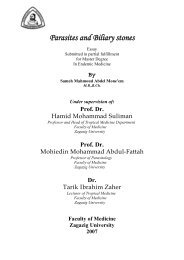E. Coli
E. Coli
E. Coli
You also want an ePaper? Increase the reach of your titles
YUMPU automatically turns print PDFs into web optimized ePapers that Google loves.
Review of Literature<br />
El-Ghamdi et al. (1999) compared antibiotic resistant E. coli<br />
isolates to ampicillin, chloramphenicol, getamicin, spectinomycin,<br />
tetracycline and trimethoprime spectinomycin, tetracycline and sulfamethoxazole<br />
ranged from 57% to 99.1% Although, amoxicillincluvalanate,<br />
ceftazidime And nitro furans ranged from zero to 2.6%<br />
resistance to spectonmycin reached 96% multi-drug resistance was<br />
alarmingly high.<br />
Lambie et al. (2000) isolated E. coli from diseased broilers. The<br />
isolates showed an increasing trend of resistance to amoxicillin,<br />
paramecia, gentamycin, nitrofurance, norfloxacin and sulphamethoxazole/<br />
trimethoprim overall, norfloxacin appeared as the best<br />
antimicrobial drug for treatment.<br />
El-Sayed et al. (2001) stated that a high level of multi-resistant<br />
strains to the antibiotic. They found that 93.3% of the strains were<br />
ampicillin resistant and 73.3% of the strains were to amoxicillin and<br />
trimethoprim-sulfamethoxazol.<br />
2.3. Pathogenic Enterbacteria in Human<br />
2.3.1. E. coli<br />
Chapman et al. (2002) reported that phage therapy viruses that<br />
specifically target pathogenic. Bacteria has been developed over the<br />
last 80 years, primarily in the former soviet union, where it was used<br />
21
















